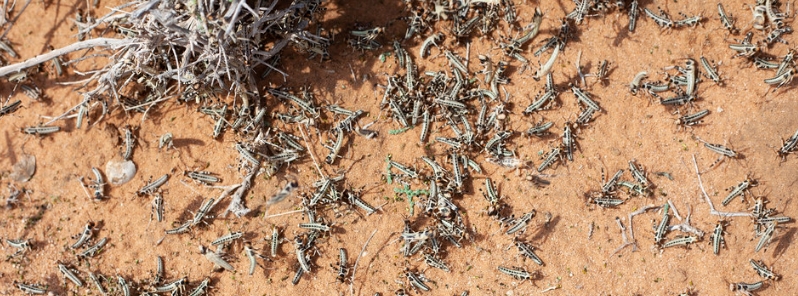Locust swarms spreading to summer breeding areas of southwest Asia and West Africa

The unprecedented threat of desert locust to food security and livelihoods continues in the Horn of Africa and it is also very likely to spread to southwest Asia and perhaps West Africa, according to a situation update by the UN Food and Agriculture Organization (FAO) on June 4, 2020.
Early migration of spring-bred swarms from southwest Pakistan to Rajasthan, India, took place in May before the monsoon and some swarms continued to northern states for the first time since 1962.
Second-generation breeding is underway in northwest Kenya and numerous hopper bands have formed that will give rise to immature swarms from the second week of June until mid-July. The same situation is underway in Somalia and Ethiopia, FAO added.
Much of the new swarms are expected to migrate northwards from Kenya to Ethiopia and traverse South Sudan to Sudan after mid-June, while other swarms will travel to northern Ethiopia.
Swarms that reach northeast Somalia are possible to migrate across the northern Indian Ocean to the Indo-Pakistan border area.

In Yemen, breeding is also underway along the southern coast and in the interior where swarms are likely to emerge, some of which could move to northern Somalia and northeast Ethiopia.
Meanwhile, control operations are ongoing in spring breeding areas of Iran, Pakistan, and India.
Pakistani and Indian authorities are working together to contain the locust invasion, considered worst in decades. In a briefing on Thursday, June 4, a spokesman from Pakistan's foreign office said a decision to work together was made at a meeting in March, involving Pakistan, India, Afghanistan, and Iran.
Each nation agreed to establish a technical and operational coordination team to share information, improve coordination at the border areas, and increase synchronization to fight the outbreak in the region.


"On its part, the government of Pakistan remains committed to cooperating with all Commission for Controlling the Desert Locust in South-West Asia (SWAC) member states, including India, in combating the desert locust outbreak," said the spokesman.
"The swarms will oscillate east and westwards before returning to lay eggs with the onset of the monsoon in Rajasthan where successive waves of swarms will arrive from southern Iran in June and the Horn of Africa in July," FAO wrote.
In Sudan, seasonal rains started recently in the extreme south of the summer breeding area, north of South Sudan. If rains continue in the following weeks, conditions are likely to be favorable for any swarms coming from Ethiopia and Kenya. These swarms are more likely to settle and lay eggs.
On the other hand, if rains are limited and conditions are dry in June, swarms would continue to eastern Chad by the end of June and move further west in the Sahel of West Africa ahead of the summer rains, reaching eastern Niger early July, eastern Mali mid-month, and southeast Mauritania later.


Featured image credit: FAO Emergencies

Do locusts have any possible food potential if collected?